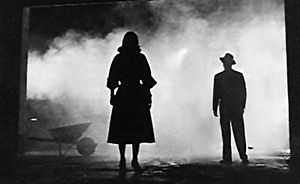Film noir facts for kids

Two shadowy figures in The Big Combo (1955). The film's camera work was by John Alton, who created many famous film noir looks.
|
|
| Years active | early 1920s – late 1950s |
|---|---|
| Country | United States |
| Influences | German Expressionism, French poetic realism, Italian neorealism, American hardboiled fiction, Art Deco (scenography) |
| Influenced | French New Wave, Neo-noir |
Film noir is a special kind of crime drama movie from Hollywood. These movies often focus on crime and corruption.
Most film noir movies were made in the United States from the early 1940s to the late 1950s. They were usually filmed in black-and-white. The name "film noir" comes from French. It means "black film" or "dark film." Film noir includes many different types of movies, like gangster films, police stories, and detective mysteries.
What Makes Film Noir Special?
Film noir movies often have many dark shadows. Sometimes, even characters' faces are hidden in shadow. This special look was inspired by German film directors like Fritz Lang. They used dramatic lighting to create a certain mood.
Another influence came from French books and movies from the 1930s. These stories often had heroes who died or had sad endings. Film noir was also shaped by crime fiction. This includes detective and crime stories by writers like Dashiell Hammett, James M. Cain, and Raymond Chandler.
Famous Film Noir Movies and Stars
Some important film noir movies include:
- Stranger on the Third Floor (1940)
- The Maltese Falcon (1941)
- Double Indemnity (1944)
- The Big Sleep (1946)
- The Postman Always Rings Twice (1946)
- Key Largo (1948)
- Touch of Evil (1958)
Famous actors from Hollywood film noir movies were Robert Mitchum, Humphrey Bogart, and Peter Lorre.
Images for kids
-
Marlene Dietrich, an actress often playing a femme fatale (a mysterious, dangerous woman).
-
The October 1934 issue of Black Mask magazine. It showed the first look of the detective character Raymond Chandler later made into Philip Marlowe.
-
Out of the Past (1947) shows many film noir features. It has a cynical private detective, a femme fatale, and many flashbacks with voiceover narration. The photography is dramatically shadowed, and the mood is fatalistic. Pictured are Robert Mitchum and Jane Greer.
-
A scene from In a Lonely Place (1950). It was directed by Nicholas Ray and based on a book by noir fiction writer Dorothy B. Hughes. Two key noir actors, Gloria Grahame and Humphrey Bogart, play lovers in the film.
-
Rita Hayworth in the trailer for The Lady from Shanghai (1947).
-
Stray Dog (1949), directed by Akira Kurosawa, has many elements like classic American film noir.
-
Jean-Paul Belmondo as car thief Michel Poiccard in À bout de souffle (Breathless; 1960). Poiccard looks up to Humphrey Bogart's movie characters. Here he copies a typical Bogart move.
-
Harrison Ford as detective Rick Deckard in Blade Runner (1982). Like many classic noirs, this film is set in Los Angeles where it always rains. The steam in the front is a common noir feature.
-
Some people think Vertigo (1958) is a noir because of its story and mood. But it has a modern graphic design and set design from the 1950s. Others say its use of color and director Alfred Hitchcock's style mean it is not film noir.
-
Barbara Stanwyck and Burt Lancaster were two of the most active stars in classic noir. The complex story of Sorry, Wrong Number (1948) has a real-time main story, many narrators, and flashbacks within flashbacks.
See also
 In Spanish: Cine negro para niños
In Spanish: Cine negro para niños













